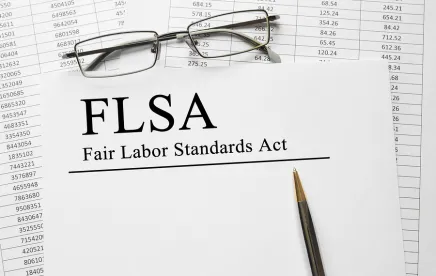The Department of Labor (the Department) published a final rule on January 7, 2021, clarifying the standard for classifying workers as employees or independent contractors under the Fair Labor Standards Act (FLSA). The final rule is scheduled go into effect on March 8, 2021, 60 days after its publication.
The rule seeks to clarify the multifactor “economic realities test,” long used by the courts, to determine whether a worker is an employee, protected by the FLSA’s minimum wage and overtime requirements; or an independent contractor, exempt from the FLSA protections.
The Five-Factor “Economic Realities Test”
The final rule, like the proposed rule published in September 2020, utilizes a five-factor “economic realities test” to evaluate whether, “as a matter of economic reality, the individual is economically dependent on that employer for work” and therefore should be treated as an employee, or is an independent contractor who is “in business for him- or herself.” The five primary factors to consider are as follows, with the first two “core factors” entitled to the most weight:
-
The nature and degree of control over the work. This factor focuses on the extent to which the individual, as opposed to the potential employer, exercises substantial control over key aspects of the performance of the work. An individual’s ability to set his or her own schedule, to select the projects to work on, and to work for others, including the potential employer’s competitors, all weigh in favor of the worker being an independent contractor.
-
The individual’s opportunity for profit or loss. This factor focuses on the extent to which the individual has an opportunity to earn profits or incur losses based on his or her exercise of initiative (such as managerial skill or business judgment) or management of his or her investment in or capital expenditure on, for example, helpers or equipment to further the individual’s work. This factor weighs toward the individual being an employee to the extent the individual is able to affect his or her earnings only by working more hours or working faster.
-
The amount of skill required for the work. Workers with specialized training or skill are more likely to be properly classified as independent contractors, while workers who rely on the training of the business they serve are more likely to be classified as employees.
-
The degree of permanence of the working relationship between the individual and the potential employer. This factor weighs in favor of the individual being an independent contractor to the extent the work relationship is by design definite in duration or sporadic, as opposed to being continuous and of an indefinite duration.
-
Whether the work is part of an integrated unit of production. This factor weighs in favor of the individual being an employee to the extent his or her work is a component of the potential employer’s integrated production process for a good or service.
Applying the Factors
According to the final rule, no one factor is dispositive. However, the final rule places special weight on the first two “core factors” in making a classification determination. The rule states that these two core factors — the nature and degree of control over the work and the opportunity for profit or loss — are the most probative as to whether an individual is an employee or independent contractor, and each therefore typically carries greater weight in the analysis than any other factor. According to the final rule, if both core factors point toward the same classification, there is a substantial likelihood that that is the correct classification.
In a departure from the proposed rule, the final rule states that the five factors are not exhaustive, and that additional factors may be relevant. However, this is the case only if the additional factors in some way indicate whether the individual is in business for themselves, as opposed to being economically dependent on the potential employer for work.
Consistent with its focus on the economic realities of the relationship, the final rule emphasizes that the actual practice of the parties is more relevant than what may be contractually or theoretically possible.
Illustrative Examples
In addition to describing in a fair amount of detail each of the five listed factors, the final rule includes six examples demonstrating how the factors may be analyzed. The examples involve an owner and operator of a tractor-trailer performing services for a logistics company; an app-based service linking homeowners to those performing home-repair work; an individual who does home renovation work for a residential construction company and also is a part owner and operator of a food truck; a housekeeper working for a ski resort; a part-time newspaper editor; and a freelance journalist. These illustrative examples are particularly helpful in demonstrating how the Department intends the rule to be interpreted.
Final Thoughts
The new rule has received a generally warm welcome from the business community. In contrast, unions and workers’ advocacy groups have expressed concerns that the rule would allow more workers to be treated as independent contractors for FLSA purposes.
The future of the new rule is uncertain. The incoming Biden administration has announced its opposition to the rule, and is expected to delay its implementation, at a minimum. In addition, the final rule is subject to rescission under the Congressional Review Act in Congress. And unions, worker advocacy groups and Democratic state attorneys general may resort to the courts to try to block the rule’s implementation.
Regardless of the fate of the new rule, it involves just one piece of the worker classification puzzle — the treatment of workers for FLSA purposes. The final rule will not affect worker classifications under state laws that apply a different test or standard, nor does the final rule affect the common law test utilized for determining the status of workers for federal payroll taxes and income tax withholding.





 />i
/>i
